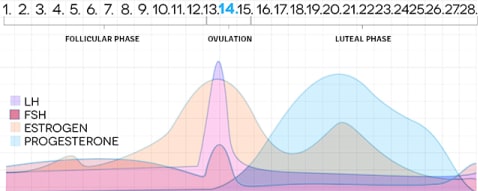Advertisement
The Hormone Workout: A Diet & Exercise Plan To Match Your Cycle

Let's talk about hormones. These signaling molecules are responsible for a lot of the things our bodies feel and do, making us hungry, tired, happy, or relaxed. And I think most women would agree that their monthly cycle can create some pretty drastic changes in how they feel each month, week, or even day.
So knowing this—can we create a lifestyle plan to match diet and exercise to our hormonal fluctuations? The answer is yes. And even though this particular post is for the females, cyclic training like I am describing is really great for all.
First, get to know your hormones.
There are so many hormones at play in a woman's hormonal cycle, but I'll keep it simple and pick two primary hormones: estrogen and progesterone. These two (along with many others) can influence metabolism, mood, hunger, insulin sensitivity, and cortisol tolerance. Here's what estrogen and progesterone are up to during the month:
Day 1-7:
The first day of a woman's menstrual cycle initiates the follicular phase. In this early phase—days 1 through 7 in a typical month—estrogen is rising and progesterone is low.
Days 7-14:
During days 7 through 14, estrogen is high and progesterone low. Day 14 is usually when you ovulate, meaning an egg moves from the ovaries to the fallopian tubes to be fertilized.
Days 14-21:
After ovulation you enter the early luteal phase. Estrogen is high and progesterone high.
Days 21-28:
Last, in the late luteal or premenstrual phase estrogen and progesterone are both falling.

Here's how to live in harmony with your hormones.
There are a ton of specific tweaks you can make in your diet and lifestyle throughout this hormonal cycle, but to make it SUPER simple, let's split the cycle into two separate halves.
1. The follicular phase
Basically, in the first half of the cycle (the follicular phase) estrogen is dominating and you are more insulin-sensitive. Estrogen can also oppose the action of insulin on LPL, which is a fat-storing enzyme—so that there tends to be less fat storage and you are also more resilient to cortisol.
This means that during the follicular phase you can tolerate more carbohydrates. Some expert trainers like Jade Teta recommend a 40:30:30 macronutrient intake (carbs:protein:fat). I tend to go a little higher on the carbs during this phase; just make sure they are plant-heavy carbs and not simple or gluten-containing carbs. Exercise at this time should be a little more cardio-focused, and this is the time to do traditionally cortisol-inducing activities like the crazy boot camp or CrossFit! You can do this three to five times a week for these two weeks of your cycle.
2. The luteal phase
During the next two weeks (the second half of your cycle is the luteal phase) you are less insulin-sensitive so you can't tolerate carbs as well. At this time some experts recommend a 30:40:30 macronutrient intake (carbs:protein:fat), but for me it means just cutting out the post-workout oats or popcorn and relying more on nuts and magnesium-rich foods like avocado and dark leafy greens.
The luteal phase is when estrogens are lower and progesterone is higher, so you are likely to be hungry. And studies report that we tend to eat more calories (anywhere from 90 to 500 more per day) during this phase. The good news is that you also burn more calories (3 to 12 percent more) in the luteal phase. Magnesium, dark chocolate, and omega-3s can help with the severe cravings in the days prior to your period.
Fewer stress-inducing activities should be done at this part of the month. Think walking, yoga, or barre three to five times a week. If none of these appeal to you then a short burst session or HIIT would also work.
Irregular cycle? Here's what to do.
For 99 percent of my patients with irregular cycles, it's stress. And I'm not talking about just stress as an emotion but stress on the body from exercise and under-eating. My favorite way to battle stress is yoga. It's also helpful to add rhodiola, ashwagandha, B vitamins, vitamin D, omega-3s, and six to eight cups of vegetables into your daily routine.
If you are on a steady-state hormone birth control, this might be a little different for you. Some hormonal birth control doesn't allow the estrogen and progesterone to fluctuate like with the natural cycle, so this plan is less applicable. I have tried this plan for myself and others and not only does it provide variety to your exercise and diet routine, but it forces you to get more in tune with your body. And that's something we can all get behind!

Dr. Amy Shah is a double board certified MD with training from Cornell, Columbia and Harvard Universities. She was named one of mindbodygreen's Top 100 Women In Wellness to Watch in 2015 and has been a guest on many national and local media shows. She helps busy people transform their health by reducing inflammation and eating more plants, utalizing the power of the microbiome to help digestion, natural hormone balance and food sensitivities. She is an expert on intermittent fasting for women and has a 2 week guided group program.
More from the author:
Functional Nutrition Training
Check out Functional Nutrition Coaching
A cutting-edge nutrition deep dive taught by 20+ top health & wellness experts
Learn moreMore from the author:
Functional Nutrition Training
Check out Functional Nutrition Coaching
A cutting-edge nutrition deep dive taught by 20+ top health & wellness experts
Learn more
Dr. Amy Shah is a double board certified MD with training from Cornell, Columbia and Harvard Universities. She was named one of mindbodygreen's Top 100 Women In Wellness to Watch in 2015 and has been a guest on many national and local media shows. She helps busy people transform their health by reducing inflammation and eating more plants, utalizing the power of the microbiome to help digestion, natural hormone balance and food sensitivities. She is an expert on intermittent fasting for women and has a 2 week guided group program.